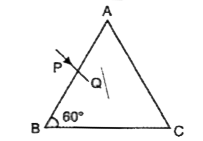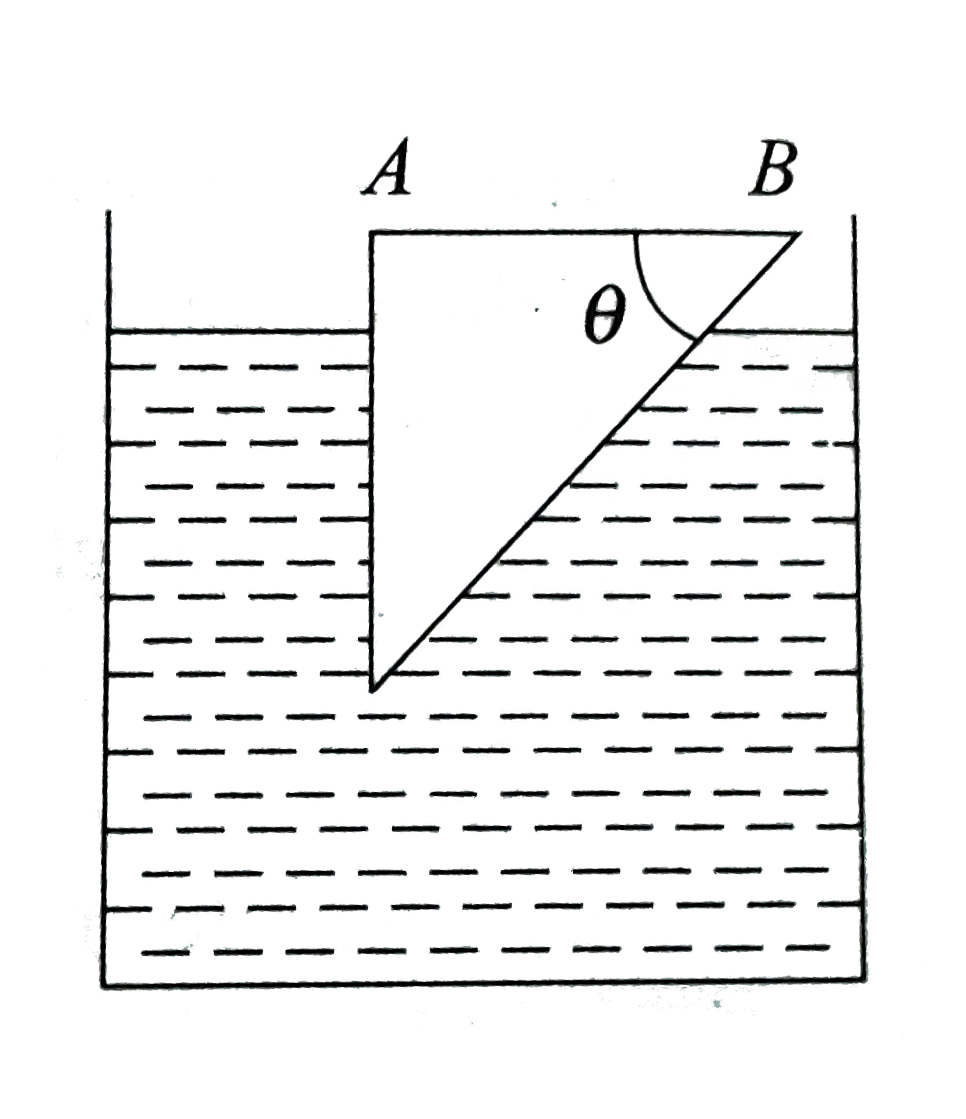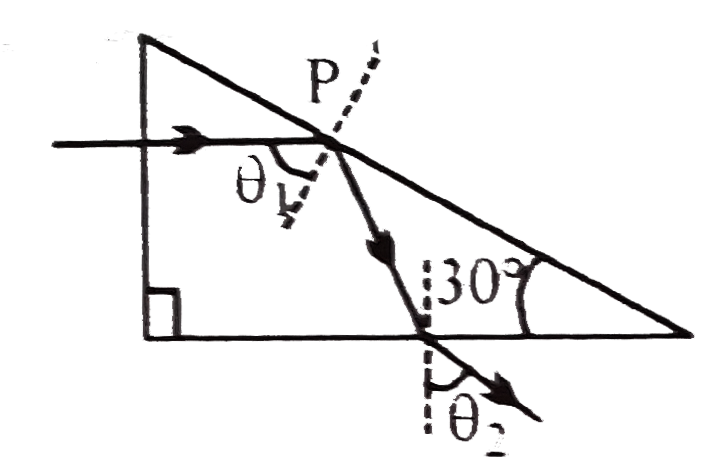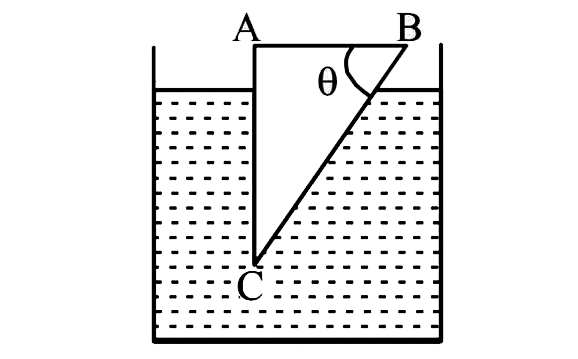(a) Show using a proper diagram how unpolarised light can be linearly polarised by reflection from a transparent glass surface.
(b) The figure shows a ray of light falling normally on. the face AB of an equilateral glass prism having refractive index 3/2, placed A in water ofrefractive index 4/3. Will this ray suffer total internal reflection on striking the face AC? Justify your answer.
(a) It is possible to transform unpolarised light in the polarised light. Polarised light waves ore light waves in which the vibration occur in a single plane, the process of transforming unpolarised into polarised is know as polarisation .
Brester angle of incident at which light with a particular polarisation is perfectly transimitted throught a transperent dielectric is perfectly transmitted throught a transparent dielectric surface. With no relflection when unpolarised light is incident at this angle, the light thal is reflected from the surface is polarised.
(b) U=1/sinC [μis refraction index]
U2/U1 and C is critical angle 3/2/4/3=1/sinC
9/8=1/sinC
sinC=8/9
C= approx 62.73∘ ray is perpendicular therefore, would not show any refraction or any reflection.
While incident ray reaches AC it would make a triangle with angle of prizm 60∘ and perpendicular Angle. Now angle of incident ray with ax is 180−60+90=30∘
Angle of incident =90−30=60∘
Since, angle of incident is less than critical angle. Ray will not suffer TIR.

Topper's Solved these Questions
- BOOK - XII BOARDS PREVIOUS YEARCHAPTER - XII BOARDSEXERCISE - SECTION - A7videos
XII BOARDS
- BOOK - XII BOARDS PREVIOUS YEARCHAPTER - XII BOARDSEXERCISE - SECTION - B9videos
XII BOARDS
- BOOK - XII BOARDS PREVIOUS YEARCHAPTER - XII BOARDSEXERCISE - SECTION - E6videos
XII BOARDS
- BOOK - XII BOARDS PREVIOUS YEARCHAPTER - SAMPLE PAPER 2019EXERCISE - SECTION D6videos
SAMPLE PAPER 2019
Similar Questions
(a) Show using a proper diagram how unpolarised light can be linearly polarised by reflection from a transparent glass surface.
(b) The figure shows a ray of light falling normally on. the face AB of an equilateral glass prism having refractive index 3/2, placed A in water of refractive index 4/3. Will this ray suffer total internal reflection on striking the face AC? Justify your answer.View SolutionIn the figure given below, a ray of light PQ is incident normally on one face AB of an equilateral glass prism. What are the angles at faces AB and AC?
 View Solution
View Solution
Knowledge Check
- Question 1 - Select One
A glass prism of refractive index 1.5 is immersed in water (refractive index 4/3) . A light beam normally on the face AB is totally reflected to reach on the face BC if
 Asinθ≥89B23<sinθ≥<89Csinθ≤23Dsinθ≤89
Asinθ≥89B23<sinθ≥<89Csinθ≤23Dsinθ≤89 - Question 2 - Select One
A ray of light is incident normally on one face of 30∘−60∘−90∘ prism of refractive index 5/3 immersed in water of refractive index 4/3 as shown in figure .
_E01_076_Q01.png) AThe exit angle of θ2 of the ray is sin−1(5/8)BThe exit angle θ2 of the ray is sin−1(54√3)CTotal internal reflection at point P ceases if the refractive index of water is increased to 52√3 by some substanceDTotal internal reflection at point P ceases if the refractive index of water is increased to 5/6 by dissolving some substance
AThe exit angle of θ2 of the ray is sin−1(5/8)BThe exit angle θ2 of the ray is sin−1(54√3)CTotal internal reflection at point P ceases if the refractive index of water is increased to 52√3 by some substanceDTotal internal reflection at point P ceases if the refractive index of water is increased to 5/6 by dissolving some substance - Question 3 - Select One
A ray of light is incident normally on one face of30∘−60∘−90∘prism of refractive index 5/3immersed in water of refractive index4/3as shown in figure.
 AThe exit angle θ2of the ray is sin−1(5/8)BTotal internal reflection at point Pceases if the refractive index of water is increased to 5/2√3by dissolving some substance.CTotal internal reflection at point P ceases if the refractive index of water is increased to 5/2√3 by dissolving some substance.DTotal internal reflection at point Pceases if the refractive index of water is increased to5/6by dissolving some substances.
AThe exit angle θ2of the ray is sin−1(5/8)BTotal internal reflection at point Pceases if the refractive index of water is increased to 5/2√3by dissolving some substance.CTotal internal reflection at point P ceases if the refractive index of water is increased to 5/2√3 by dissolving some substance.DTotal internal reflection at point Pceases if the refractive index of water is increased to5/6by dissolving some substances.
A light ray falls perpendicular on one face of an equilateral prism having refractive index √2 .The angle of deviation is :
View SolutionA ray of light is incident normally on one face of an equilateral prism of refractive index 1.5. The angle of deviation is: (Given sin−1.23=42∘)
View SolutionA glass prism of refractive index 1.5 is immersed in water (refractive index 4/3). A light beam incident normally on the face AB is totally reflected to reach on the face BC if.
 View Solution
View SolutionA glass prism of refractive index 1.5 is immersed in water (refractive index 4/3). A light beam incident normally on the face AB is totally reflected to reach on the face BC if
 View Solution
View SolutionA glass prism of refractive index 1.5 is immersed in water (refractive index 4/3). A light beam incident normally on the face AB is totally reflected to reach the face BC, Fig. if :
 .View Solution
.View Solution
